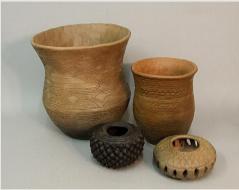

Historical & Ancient Ceramic Technology, Workshops, Demonstrations & Replicas

Prehistoric Pottery Replicas by Graham Taylor of Potted History

In Britain, Prehistoric Pottery is the collective term for any pots made during the Neolithic (Stone Age), (Chalcolithic) Copper age, Bronze Age or Iron Age, in fact any ceramics made prior to the Roman invasion of 43AD. With possible rare exceptions of continental potters setting up workshops along the south coast during the 1st Century BC, all Prehistoric pottery in Britain was made by hand, without the use of the potters' wheel. It was also the Romans who introduced widespread use of kilns, almost all pre Roman pottery in Britain having been 'open fired', a process that fires the pots up to a temperature of about 600 to 800 degrees Centigrade, creating serviceable but fragile pottery. The first pots known in Britain, Carinated Bowls or Grimston Wares, make their apperance around 4000BC, and set the trend for the development of other round bottommed forms throughout the Neolithic period: Mortlake Bowls, Unstan Ware; Abingdon Ware and Windmill Hill Ware to name but a few. It is only with the development of Grooved Ware in the third millennium BC, that we see extensive adoption of flat bottomed pots. Probably originating in Orkney, and possibly in response to the furnishing of houses with flat surfaces, it is Grooved Ware was in use at places like Durrington Walls and Avebury during the first phase of building at Stonehenge. Metal in the form of Gold and Copper are first seen in Britain around about 2500BC and along with these new materials come Pottery Beakers. Often taken as a marker of the end of the Neolithic and the beginning of the Bronze Age, Beaker Culture spans the boundary between the two. The Early to middle Bronze-Age sees the development and introduction of a wide range of different, often highly decotrated, pottery forms. Many of the smaller pots, often referred to as accessory vessels, Incense cups or pygmy cups, remain an egnigma, their use and function being little understood, this includes objects such as: Grape Cups, Fenestrated cups, Aldbourne Cups etc. Later in the Bronze age changes in funerary practice also see the introduction of very large pots such as Collared Urns. Towards the end of the Bronze Age and going forward into the Iron Age the quality and range of pottery seems to deteriorate markedly, particularly in Northern Britain some areas of which seem to abandon its use entirely. During the Iron Age Southern Britain benefits to some extent from continental influences and the import of fine Gaulish wheel made pottery.






































